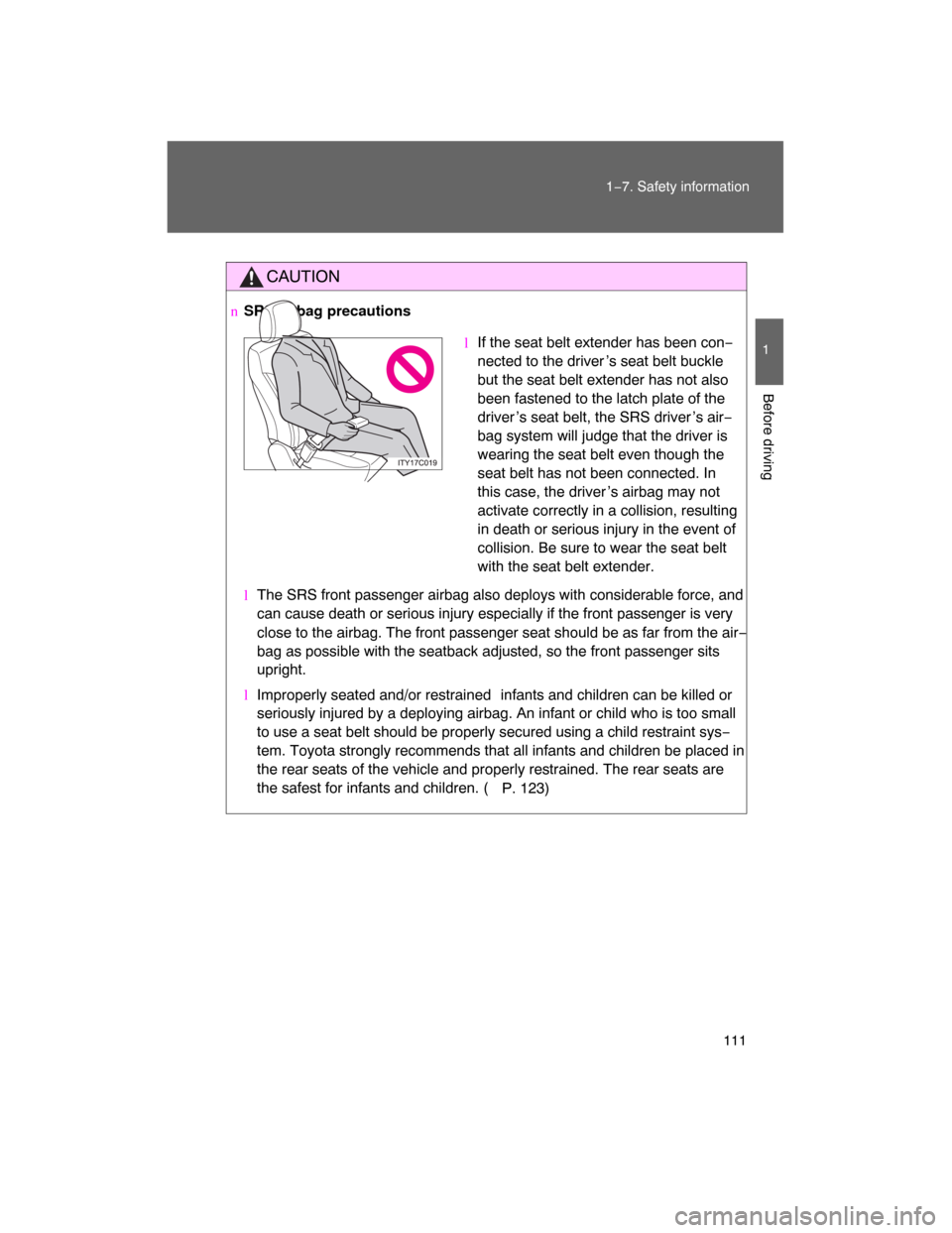Page 109 of 531

110 1−7. Safety information
CAUTION
nSRS airbag precautions
Observe the following precautions regarding the airbags.
Failure to do so may cause death or serious injury.
lThe driver and all passengers in the vehicle must wear their seat belts
properly.
The SRS airbags are supplemental devices to be used with the seat belts.
lThe SRS driver airbag deploys with considerable force, and can cause
death or serious injury especially if the driver is very close to the airbag.
The National Highway Traffic Safety
Administration (“NHTSA”) advises:
Since the risk zone for driver airbag is the first 2 − 3 in. (50 − 75 mm) of
inflation, placing yourself 10 in. (250 mm) from your driver airbag provides
you with a clear margin of safety. This distance is measured from the cen−
ter of the steering wheel to your breastbone. If you sit less than 10 in. (250
mm) away now, you can change your driving position in several ways:
�Move your seat to the rear as far as you can while still reaching the
pedals comfortably.
�Slightly recline the back of the seat.
Although vehicle designs vary, many drivers can achieve the 10 in.
(250 mm) distance, even with the driver seat all the way forward, sim−
ply by reclining the back of the seat somewhat. If reclining the back of
your seat makes it hard to see the road, raise yourself by using a firm,
non−slippery cushion, or raise the seat if your vehicle has that feature.
�If your steering wheel is adjustable, tilt it downward. This points the air−
bag toward your chest instead of your head and neck.
The seat should be adjusted as recommended by NHTSA above, while still
maintaining control of the foot pedals, steering wheel, and your view of the
instrument panel controls.
Page 110 of 531

111
1−7. Safety information
1
Before driving
CAUTION
nSRS airbag precautions
lThe SRS front passenger airbag also deploys with considerable force, and
can cause death or serious injury especially if the front passenger is very
close to the airbag. The front passenger seat should be as far from the air−
bag as possible with the seatback adjusted, so the front passenger sits
upright.
lImproperly seated and/or restrained infants and children can be killed or
seriously injured by a deploying airbag. An infant or child who is too small
to use a seat belt should be properly secured using a child restraint sys−
tem. Toyota strongly recommends that all infants and children be placed in
the rear seats of the vehicle and properly restrained. The rear seats are
the safest for infants and children. (
P. 123)
lIf the seat belt extender has been con−
nected to the driver ’s seat belt buckle
but the seat belt extender has not also
been fastened to the latch plate of the
driver ’s seat belt, the SRS driver ’s air−
bag system will judge that the driver is
wearing the seat belt even though the
seat belt has not been connected. In
this case, the driver ’s airbag may not
activate correctly in a collision, resulting
in death or serious injury in the event of
collision. Be sure to wear the seat belt
with the seat belt extender.
Page 111 of 531
112 1−7. Safety information
CAUTION
nSRS airbag precautions
lDo not sit on the edge of the seat or
lean against the dashboard.
lDo not allow a child to sit on the knees
of a front passenger while the vehicle is
moving.
lDo not drive the vehicle while the driver
or passenger have items resting on
their knees.
lDo not lean against the door, the roof
side rail or the front, center and rear pil−
lars.
l
Do not allow anyone to kneel on the
passenger seats toward the door or put
their head or hands outside the vehicle.
ITY17C021
ITY17C023
Page 112 of 531
113
1−7. Safety information
1
Before driving
CAUTION
nSRS airbag precautions
lDo not attach anything to or lean any−
thing against areas such as the dash−
board or steering wheel pad or lower
portion of the instrument panel. These
items can become projectiles when
SRS driver, front passenger and knee
airbags deploy.
lDo not attach anything to areas such as
the door, windshield glass, side door
glass, front, center and rear pillars, roof
side rail or assist grip.
l
Do not hang coat hangers or other hard
objects on the coat hooks. All of these
items could become projectiles and
seriously injure or kill you, should the
SRS curtain shield airbag deploy.
ITY17C029
ITY17C031
Page 113 of 531

114 1−7. Safety information
CAUTION
lIf the vinyl cover is put on the area where the SRS knee airbag will deploy,
be sure to remove it.
lDo not use seat accessories which cover the front seat as they may inter−
fere with inflation of the front passenger airbag.
lDo not use seat accessories which cover the parts where the SRS side
airbags inflate as they may interf
ere with inflation of the airbags.
lDo not strike or apply significant levels of force to the area of the SRS air−
bag components shown on P. 104. Doing so can cause the SRS airbags to
malfunction.
lDo not touch any of the component parts immediately after the SRS air−
bags have deployed (inflated) as they may be hot.
lIf breathing becomes difficult after the SRS airbag has deployed, open a
door or window to allow fresh air in, or leave the vehicle if it is safe to do
so. Wash off any residue as soon as possible to prevent skin irritation.
lIf the areas where the SRS airbags are stored, such as the steering wheel
pad and front pillar garnish, are dam
aged or cracked, have them replaced
by your Toyota dealer.
Page 114 of 531
115
1−7. Safety information
1
Before driving
CAUTION
nModification and disposal of SRS airbag system components
Do not dispose of your vehicle or per
form any of the following modifications
without consulting your Toyota dealer. The SRS airbag may malfunction or
deploy (inflate) accidentally, causing death or serious injury.
lInstallation, removal, disassembly and repair of the SRS airbags
l
Repairs, modifications, removal or replacement of the steering wheel,
instrument panel, dashboard, seats or seat upholstery, front, center and
rear pillars or roof side rail
lRepairs or modifications of the front fender, front bumper, or side of the
occupant compartment
lInstallation of snow plows, winches, etc. to the front grille (bull bars, kan−
garoo bar etc.)
lModifications to the vehicle’s suspension system
lInstallation of electronic devices such as mobile two−way radios or CD
players
l
Modifications to your vehicle for a person with a physical disability.
Page 115 of 531
116 1−7. Safety information
Deactivating the curtain shield airbags in a vehicle rollover
On/off (Pressing longer)
The “RSCA OFF” (roll sensing of
curtain shield airbags off)
indicator light turns on.
(Only when the “ENGINE START
STOP” switch OFF.)
nThis switch only should be used
In a situation where the inflation is not desired (such as during extreme off
road driving).
nOperating conditions when the “RSCA OFF” indicator turns on
lThe curtain shield airbag and seat belt pretensioner will not activate in a
vehicle rollover.
l
The curtain shield airbag will activate in a severe side impact.
CAUTION
nWhile normal driving
Make sure the “RSCA OFF” indicator light is not turned on. If it is left on, the
curtain shield airbag will not activate in the event of an accident, which may
cause death or serious injury.
Page 116 of 531
117
1
1−7. Safety information
Before driving
Front passenger occupant classification system
Your vehicle is equipped with a front passenger occupant classifica�
tion system. This system detects the
conditions of the front passen�
ger seat and activates or deactivates the devices for front passenger.
SRS warning light
AIR BAG OFF indicator light
AIR BAG ON indicator light
Front passenger ’s seat belt reminder light